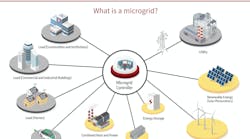Our most-read story defines what a microgrid is. Now it’s time to define what a microgrid is not because there is a lot of confusion.
And it’s no wonder. The energy transition is propagating a stream of new energy terms for businesses, communities and homeowners to sort through as they try to take control of their energy supply.
So here are four technologies that I find most commonly misconstrued as microgrids. Please feel free to share this article with anyone you know who may benefit.
Solar and storage is not a microgrid
In the ancient days of microgrids (five years ago), confusing microgrids with solar and storage was a common mistake. Some people even thought rooftop solar alone qualified. (For more on that see Solar is Good. Solar Microgrids are Better.)
Solar and storage systems use solar panels to generate energy by day and store it in batteries for use in the evening or during a power outage. It’s an attractive option for homeowners who want clean energy and better electric reliability. But such systems don’t guarantee 24/7 electricity as a microgrid does. The battery may be depleted before it can recharge. For that reason, you’re unlikely to find mission-critical facilities relying solely on solar and storage.
These days, we get fewer news releases proclaiming a solar and storage system to be a microgrid, so this misunderstanding may be waning. But the confusion is understandable because a lot of microgrids use solar and storage.
The key difference is that a microgrid contains a controller that allows it to disconnect or “island” from the grid during a power outage and use its on-site power to serve its host. When the power outage ends, it can reconnect to the grid and interact with it to produce the cleanest, cheapest and most efficient mix of energy from available resources.
A virtual power plant is not a microgrid
So what exactly is a virtual power plant or VPP? If you’re uncertain, it’s not surprising because the definition has evolved. A decade or more ago, the term was used to describe energy saving measures that avert the need to construct physical power plants. Then batteries became cheaper and are now a dominant technology used to form a VPP.
VPPs may also use other distributed energy resources (DERs), including solar and storage combos, thermal storage, electric vehicles and grid-interactive appliances and buildings. Acting in the aggregate, a VPP’s resources deliver energy and services to the grid that would otherwise be provided by a power plant — and do it cleaner or cheaper or both.
You’re probably thinking, OK, that sounds like a microgrid. Yes, a microgrid uses multiple DERs and can send energy and services to the grid, too. But a microgrid is itself a small grid and a VPP is not. This small grid can provide power to a community or business independent of the main grid. In fact, some microgrids never connect to a central grid. A VPP, meanwhile, by definition, serves the grid.
To complicate this more, a microgrid can act as a VPP. Check out this project by IKEA in Australia.
Community solar is not a microgrid
Initially called “solar gardens,” community solar mimics the idea of a community vegetable garden — a communal resource that feeds the neighborhood, but in this case, it provides energy instead of food. These are typically relatively large solar installations that offer subscriptions. The subscribers don’t receive solar energy directly from the plant — there isn’t a physical connection. Instead, they receive solar credits. It’s a good approach for people who want to support clean energy but can’t install solar panels on their roofs, perhaps because they lack the space or are renters.
People confuse community solar and community microgrids. But they are very different. Most importantly, a microgrid provides power to its host when the grid is down, while a community solar project does not.
But to muddle things a bit, a community solar project can be part of a community microgrid, as Scale Microgrid Solutions is demonstrating with its Gallaudet University project, a winner in this year’s Microgrid Knowledge Greater Good Award competition.
DERMS is not a microgrid
It’s understandable why people sometimes conflate distributed energy resources management systems (DERMS) with microgrids because DERMS manage DERs and so do microgrids. But that’s about as far as the similarities go. A DERMS is a software platform, often used by utilities, to see and organize the many DERs now connecting to the grid. A microgrid, meanwhile, manages its own internal DERs. DERMS do not island from the grid or provide power to hosts during a power outage — something microgrids can do. Here’s a white paper by PXiSE that explains DERMS in more detail.
I’m guessing microgridders are finding other sources of confusion about what is and what is not a microgrid. Perhaps vehicle-to-grid should be added to the list? We’d love to hear about the technologies that you hear people conflate with microgrids. Let us know!
Track news about today’s energy revolution. Subscribe to the free Microgrid Knowledge Newsletter.








